Immortal Muse by Stephen Leigh: Review, Interview, and Prelude to a Secret Chapter

Stephen Leigh is a Cincinnati-based, award-winning writer of science fiction and fantasy, with thirty novels and nearly sixty short stories published. He has also published fantasy under the pseudonym S.L. Farrell. He has been a frequent contributor to the Hugo-nominated shared-world series Wild Cards, edited by George R.R. Martin. Stephen taught creative writing for twenty years at Northern Kentucky University, and has recently retired (but not from writing). His most recent novels have been Amid The Crowd Of Stars, the SunPath duology of A Fading Sun and A Rising Moon, The Crow of Connemara, and Immortal Muse. His latest novel, Bound To A Single Sun, will be published by DAW Books next year. Stephen is married to Denise Parsley Leigh; they are the parents of a daughter and a son; he is a musician and vocalist too, active in several Cincinnati bands.
In 2014, Stephen Leigh published his Immortal Muse novel (check out the 2014 Black Gate release), an alternative-history, fantasy fictionalizing alchemy’s role in artistic muses. Wow! Of course, Leigh had to be interviewed as part of the “Beauty in Weird Fiction” interview series. Indeed he was interviewed in 2016 before the interview series merged into Black Gate. If you are interested in the aesthetics of horror and weird fantasy, check out the thoughts of our recent guests like Darrell Schweitzer, Sebastian Jones, Charles Gramlich, Anna Smith Spark, Carol Berg, & Jason Ray Carney (full list of interviews at the end of this post).
This post wraps up (1) a review of Immortal Muse, (2) the interview with the author on Leigh’s muses, and (3) teases readers within an announcement. Okay, we’ll cover that last one first. There is a missing/deleted chapter from Immortal Muse that Stephen Leigh will be posting on Black Gate soon, over 11K words with annotations on (a) why it was left out of the final book and (b) how facts were woven into this fantastical alternative-history. It serves as both a stand-alone short story and an engaging behind-the-scenes look at writing. The article with the missing chapter is posted (look here).
Let this review and interview stoke your creative fires.
1) Immortal Muse Review
Stephen Leigh’s Immortal Muse blends modern-day fiction with alchemical history. As a chemist and artist, and fantasy genre fan, this was a perfect match for me. How neat would it be if your muse was not just a one-way source of inspiration? What if your muse was a person who provided feedback and even shared a symbiotic relationship with you such that your creations benefited her? What if your muse’s life was threatened by a darker counterpart?
“Yeah, artists want immortality all right, but the immortality we’re after is the kind you don’t know you achieved because you’re dead when it happens. It’s the work that’s supposed to live forever. Not the artist.”
Complementary Art & Alchemy:
Prior to 1600, scientists and artists had overlapping interests/skills; scientists had to draw their own data in sketchbooks; conversely, artists had to craft/prepare their own pigments and materials (via chemistry). Artists and alchemists frequented the same apothecaries. The art & science of transmuting materials was a shared goal. Alchemists codified their goal in the substance called the “philosopher’s stone,” which was either the understanding to transmute materials into anything they wanted (i.e. gold)…or the base material itself. Harnessing the power of the stone could also enable one to live forever (in which case the “stone” was called “the elixir of life”).
Immortal Muse blends these complementary disciplines. It is half contemporary fantasy (New York, 2010), and half Historical Fiction, which covers a range of times, European geographies, and art (detailed below). This is an entertaining soap-opera/thriller.
- 1400, Paris: Perenelle Flamel & Nicolas Flamel (scribes, alchemists)
- 1635, Rome: Gian Lorenzo Bernini (Roman artist &sculptor)
- 1737, Vienna: Antonio Lucio Vivaldi (Musician)
- 1790, Paris: Jacque-Louis David (Painter)
- 1814 England: William Blake, Percy Bysshe Shelly (Poets)
- 1900 Vienna: Gustave Klimt (Painter)
- 1940 Nice, Italy: Charlotte Salomon (Jewish artist)
Artistic Philosophy:
Immortal Muse is chock full of artistic perspectives and shout-outs. I was thrilled for the mention of my favorite artisanal recipe book: Mappae Clavicula: A Little Key to the World of Medieval Techniques. There is a somber but nicely executed arc regarding the persecution of Jews, beginning with the ~1394 Jewish migration from Paris and ending with Charlotte Salomon’s tragic plight during the Holocaust. There are plenty of moments like the quote below in which an artist is caught between following their muse (and creating something to be shared) and lacking the trust of the audience to care or judge them (or having their art taken away).
“Ana let the pages of the sketchpad fall back and handed it to [Charlotte]. She pressed it to her chest as if she’d never expected to have it returned.”
Stephen Leigh taps his own artistic experience for this. As a musician and creative writer, who also practices Aikido, it is obvious that he funneled a lot of his own muses in this. I half wonder if there is a bar called the Bent Calloipe in Cincinnati where he plays his guitar. His Immortal Muse is recommended for historical fiction, art philosophy, alchemy buffs, and fantasy enthusiasts. Let’s learn more about his muses by cornering him for an interview:
2) Stephen Leigh (SL) Interview
Originally recorded in 2016 on SElindberg.com.
SE: Pseudonyms & Genre Muses: You’ve written dozens of novels in various genres. Do you have different muses per genre?
SL: No, I just have wide tastes in what I like to read, which means I have similarly wide tastes in what I like to write. To my mind, there’s only one Muse, no matter what creative endeavor I’m engaged in or what genre I’m writing.
Cross-over Muses: Is there any muse that inspired you to express something in multiple forms? If so, please identify the books/music that are connected. If not, have you considered linking the content of your music and writing?
In CROW OF CONNEMARA, my latest book (like IMMORTAL MUSE, a stand-alone novel… sorta), one of the main protagonists is a musician. As a result, there’s a lot of Celtic music referenced and quoted in the novel, and at one point, he sings one of his ‘original’ songs… but of course that’s one of mine, actually. Unfortunately, though I’ve played the song out several times on gigs, I don’t have a recording of it to share…
Similarly, in the WILD CARDS shared world series (edited by George RR Martin), with which I’ve been involved since the beginnings way back in the mid-80s, one of my characters is “Drummer Boy”, who’s in a band called “Joker Plague.” The Joker Plague lyrics I’ve quoted in a few books in that series are all mine, some from songs I’ve written, other just made up for the situation.
Fine Arts: You play in bands and write, but your bachelor’s degree is in Fine Arts. Any chance your foundations will emerge publicly? Is there a sketch, photograph, or painting we can share?
Here are a few… Below is a sketch I did a few years back — of nothing in particular, just a landscape in my head…
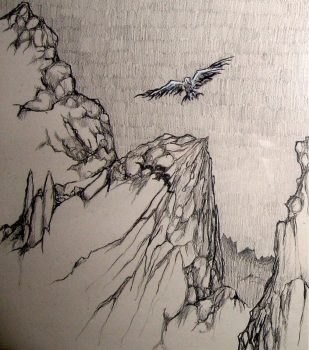
Here are a couple of others, another pencil sketch and a watercolor, again imaginary landscapes.
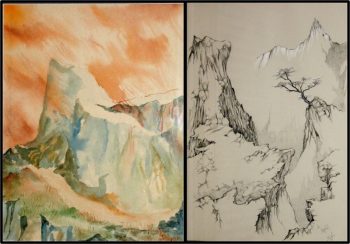
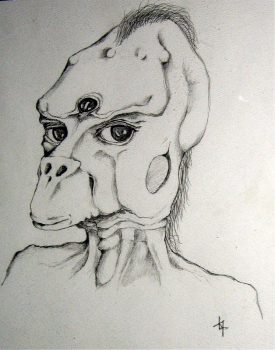
And just for a change of pace, I drawing I did of a Miccail for DARK WATER’S EMBRACE, which never went into the original publication, but was added when I got the rights back to the book and re-published the novel through Arc Manor/Phoenix Press — that version’s still available on Amazon.
Oh… and for epic fantasy books set in alternate worlds, I generally create a map to help me ‘see’ the landscape of the world. You’ll find such in the Cloudmages series (by S.L. Farrell: HOLDER OF LIGHTNING, MAGE OF CLOUDS, and HEIR OF STONE) and in the Nessantico Cycle (also by S.L. Farrell: A MAGIC OF TWILIGHT, A MAGIC OF NIGHTFALL, and A MAGIC OF DAWN) — for all of those, I created the maps that are in the books.
Pubs and Beer: Is there a bar/pub within greater Cincinnati/Newport that inspired Immortal Muses’ “Bent Calliope”? Is there a coven of artisans who meet there?
I like the idea of a ‘coven’ of creative types, but I’m afraid not; the Bent Calliope was wish fulfillment on my part. I’ve played music in (and had a drink or two in) lots of bars and taverns over the decades. I wish here was a local bar like that — a kind of creative “Cheers” where everybody knows your name (and what you wrote/composed/drew/painted/sculpted/published), and where a real Muse occasionally dropped in to enhance what you were doing — wouldn’t that be nice!
But if one exists, I’ve yet to find it. Alas.
Art & Alchemy? Prior 1600, scientists and artists had overlapping interests/skills; scientists had to draw their own data in sketchbooks; conversely, artists had to craft/prepare their own pigments and materials (via chemistry). Artists and alchemists frequented the same apothecaries. The art & science of transmuting materials was a shared goal. What inspired you to fictionalize alchemical history and begin Immortal Muse?
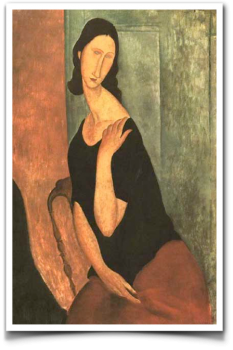
In doing that, I noticed that many of Modigliani’s portraits were of the same woman, Jeanne Hébuterne. Here’s one. So I also googled Jeanne Hébuterne, and came across a photograph of her.SL: Honestly, the alchemy came in late in the process — for me, inspiration for novels generally springs from more than one source. Here’s how it happened with IMMORTAL MUSE… (It’s a longish tale, so settle in…I’ll try to be concise. Honest.) In January of 2010, I’d finished A MAGIC OF DAWN, the last of the ‘Nessantico Cycle’ books (written as “S.L. Farrell”) and I’d begun thinking about what I wanted to write next. In the mornings, I generally go through a short list of websites as part of my routine; one site was the BBC’s “Pictures of the Day” (alas, they no longer do this…) where they collected striking photographs from around the world. That day, one of the pics showed a woman reflected in (I believe) a hubcap, which stretched and elongated her figure. Huh, I thought, that reminds me of the Modigliani paintings from my Art History classes… which sent me off googling Modigliani.
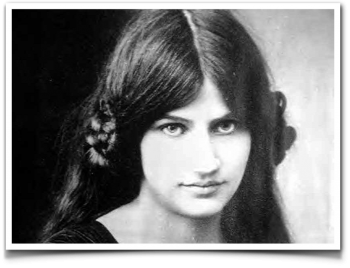
I was immediately struck by her, especially those wonderful, dark, soul-searching eyes. I looked up the incredibly tragic story of the love affair between Jeanne and Amedeo (I’ll leave it to the reader to find that for themselves). I also wrote a blog post about that bit of serendipitous research, the last line of which was: “If a (much younger and unattached) me were sent back to 1916 or so, I might go looking for Jeanne. Maybe I’ll just put her in a story instead…” Mind you, I had no thoughts of actually doing that at that moment. But the thought was now in my subconscious.
So, moving on… I habitually read a lot of non-fiction (I think of it as “mining for ideas”) and one such was a book by Francine Prose called THE LIVES OF THE MUSES, about several well-known women who had been the muses of and influenced the artistic creations of the artists whom they loved. It was a decent book that I enjoyed reading (though someone needs write a book which includes male muses…). And I started wondering: What if… What if there was a genuine Muse, a person who literally did enhance the creativity of an artist? Maybe that could be my next book: an urban fantasy around that concept. Hmm… But I couldn’t quite find the ‘hook’ I wanted in that idea. (And so that thought went into the subconscious hopper, too).
While I was flailing around, I read through some old novel proposals I’d started and abandoned. One was about two immortal people chasing each other through time. The proposal really sucked (which is why I never sent it out), but I found that I still had some fascination with the core idea there. (Into the hopper…)
Thinking about immortality took me into doing some research on alchemy, which quickly led me to Nicolas and Perenelle Flamel, and the story that after Nicolas died (as a fairly rich man), grave robbers broke into his tomb because they thought there might be valuables buried with him… and found that the tomb was empty. And there were rumors that people had glimpsed Nicolas and Perenelle long after their supposed deaths. Hmm… Into the hopper.
I was also at the time reading another non-fiction book (translated from French) called PARIS IN THE MIDDLE AGES, by Simone Roux. It looks at the same timeframe as the Flamels (though it doesn’t particularly mention them) but there were lovely atmospheric details in the book that drew me into wanting to set a story in Paris in that time. Yes, into the hopper…
And (finally, at last!), at a dinner with some friends, we started talking about vampires and why every other book in the bookstores at that time seemed to be another vampire story. (No, IMMORTAL MUSE has no vampires!) I posited during that conversation that one reason vampires had such popularity is that can potentially live forever, and that hey, I might be willing to trade having to suck blood from the living for that chance. (Into the hopper…)
It all came together in the shower, a morning or two after that conversation. (I know, try to get that image out of your mind…) What if — again, that lovely seminal phrase for so much science fiction and fantasy — Perenelle Flamel had been Nicolas’ muse, and he hers in return? What if she, not he, created the immortality potion that was half of the Philosopher’s Stone? What if that accomplishment really ticked off Nicolas? What if — as a result of taking the elixir — she was ‘cursed’ (somewhat vampirically, if I can coin a word) by being required to ‘feed’ on creative energy: she must be a Muse for the entirety of her immortal life? What if Nicolas has also taken her potion and has been similarly cursed (though he ‘feeds’ on physical pain — in the book, Nicolas is not a good person). He is chasing Perenelle through time, eternally angry with her? What if some of these famous artistic muses of history were actually Perenelle?
Aha… The structure of the book began to fall together for me: a ‘present-day’ thread that would go through the entire novel, with historical tales layered in-between. Why, Modigliani and Jeanne could be one of those… I wrote up the proposal in a creative heat in March of 2010 and sent it to Sheila Gilbert at DAW, who’s my editor; she loved it. I started researching artists and muses, and putting together the book…
Mind you, the book would undergo several significant and major changes during the writing and revisions. For instance, I wrote up a long (15,000 words or so) historical segment with Modigliani and Jeanne that I really liked, then realized that for a few good reasons it didn’t work with the overall arc of the book, and ended up reluctantly cutting it. A similarly long and completed Nathaniel Hawthorne sequence was likewise abandoned, as were unfinished segments with Sonya Noskowiak (a photographer) and Artemisia Gentileschi (one of my favorite Baroque painters). The Gustav Klimt, Charlotte Salomon, and Antoine-Laurent de Lavoisier segments emerged late in the revisions, partially as ‘replacements’ for the cut sections.
Sometimes, no matter how fond you are of what you’ve written, no matter how much effort and labor you’ve put into the creation of a segment, you have to kill it to make the book a better book.
Is there a specific Klimt or Salomon work that you worked from?
I’ve always been fascinated by Klimt’s paintings and drawing, and his distinctive style. From a research standpoint, I read GUSTAV KLIMT: Painter of Women by Susanna Partsch, as well as VIENNA MODERNISM 1890 – 1910 by Isabella Ackert, along with some online, spur-of-the moment research at need. Again, I borrowed real historical characters from his life and times, but the ‘Perenelle’ in this timeframe, unlike most of the others, is entirely fictional.
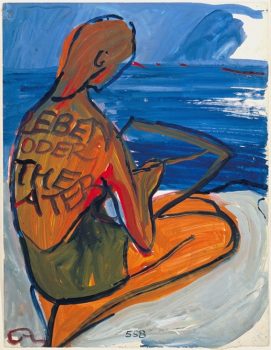
Charlotte Salomon I hadn’t been familiar with, but in researching artists of the WWII era (because I felt I needed someone from that timeframe), I came across her and was fascinated by her story. Like Anne Frank, her life was tragically cut short, and who knows what she might have done had she lived. Still, her evocative autobiographical paintings are a great legacy. For research there, I read TO PAINT HER LIFE: Charlotte Salomon in the Nazi Era by Mary Lowenthal Felstiner, as well as doing a fair amount of research into the political environment in France at the time.
For those interested in what was true and where I took fictional liberties in the various historical eras, I detail that in the Afterword of IMMORTAL MUSE.
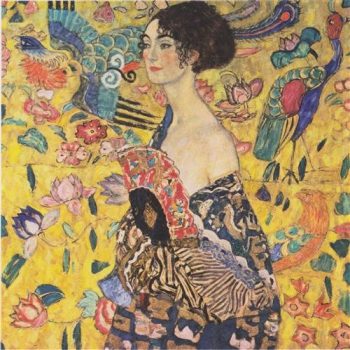
Waiting for a Muse: In your essay “TenThings I’ve Learned (As A Writer)” you address how mature professionals have to move past waiting for their muses [more essays online]. Can you comment on your current relationship with your muse? Is she understanding that you can’t always work on her timing?
4: Make writing a dirty habit
In my early career, I waited for the muse to appear before I wrote. I thought stories were supposed to flow in sparkling fire from my pen to the page, fully formed and perfect. I’d always been told (by people who weren’t writers themselves but who taught literature) that this was how Capital-A Art worked.
That’s complete and utter bullshit.
… What I slowly realized was that if I hoped to forge a career as a writer, I couldn’t wait for the fickle muse to appear. I had to write without her… because once you start writing, the muse can’t stand to be left out and eventually shows up at your side. The very act of writing attracts the muse to you.” – S.L. Farrell
I think it’s more a matter of me realizing that my job is to write, whether or not the Muse sits down with me or not. If what spews out onto the page is crap, well, that’s why we revise (and revise, and revise again). Unlike the math tests I remember in school, writers don’t have to ‘show their work.’ No one except the writer is required to read the ugly, deformed drafts or view all the changes that get made, scenes we’ve cut, rearrangements we’ve made, mistakes we’ve made and corrected, essential foreshadowing we added at the last minute, and so on.
If you persist, eventually the Muse does show up. Eventually. At some point, things start to gel and come together. All we give our readers is the final, polished version. My task as a writer is to make sure that what I send out to Sheila and other editors is the best I’m capable of writing at the time. If I don’t like what I’ve written, then it doesn’t go out. If I can honestly say that I couldn’t write the story any better than I’ve written it at this point in time and with the skill that I currently have, then I’ve done my job (and so has my Muse).
If the editor to whom I send the piece passes on it, that’s their decision — it happens. If a reader, once the piece is published, doesn’t care for it, well, that happens too; I’ve no control over that. Writers write. Once the writing is done and the work has found a home somewhere, our job’s done.
Thanks to Stephen Leigh for taking the time for revealing all these details.
Keep an eye out for the posting of the deleted chapter from Immortal Muse!
Interview List Regarding #Weird Beauty on Black Gate
- Darrel Schweitzer THE BEAUTY IN HORROR AND SADNESS: AN INTERVIEW WITH DARRELL SCHWEITZER 2018
- Sebastian Jones THE BEAUTY IN LIFE AND DEATH: AN INTERVIEW WITH SEBASTIAN JONES 2018
- Charles Gramlich THE BEAUTIFUL AND THE REPELLENT: AN INTERVIEW WITH CHARLES A. GRAMLICH 2019
- Anna Smith Spark DISGUST AND DESIRE: AN INTERVIEW WITH ANNA SMITH SPARK 2019
- Carol Berg ACCESSIBLE DARK FANTASY: AN INTERVIEW WITH CAROL BERG 2019
- Byron Leavitt GOD, DARKNESS, & WONDER: AN INTERVIEW WITH BYRON LEAVITT 2021
- Philip Emery THE AESTHETICS OF SWORD & SORCERY: AN INTERVIEW WITH PHILIP EMERY 2021
- C. Dean Andersson DEAN ANDERSSON TRIBUTE INTERVIEW AND TOUR GUIDE OF HEL: BLOODSONG AND FREEDOM! (2021 repost of 2014)
- Jason Ray Carney SUBLIME, CRUEL BEAUTY: AN INTERVIEW WITH JASON RAY CARNEY (2021)
- interviews prior 2018 (i.e., with John R. Fultz, Janet E. Morris, Richard Lee Byers, Aliya Whitely …and many more) are on S.E. Lindberg’s website
S.E. Lindberg is a Managing Editor at Black Gate, regularly reviewing books and interviewing authors on the topic of “Beauty & Art in Weird-Fantasy Fiction.” He is also the lead moderator of the Goodreads Sword & Sorcery Group and an intern for Tales from the Magician’s Skull magazine. As for crafting stories, he has contributed five entries across Perseid Press’s Heroes in Hell and Heroika series and has an entry in Weirdbook Annual #3: Zombies. He independently publishes novels under the banner Dyscrasia Fiction; short stories of Dyscrasia Fiction have appeared in Whetstone and Swords & Sorcery online magazines.